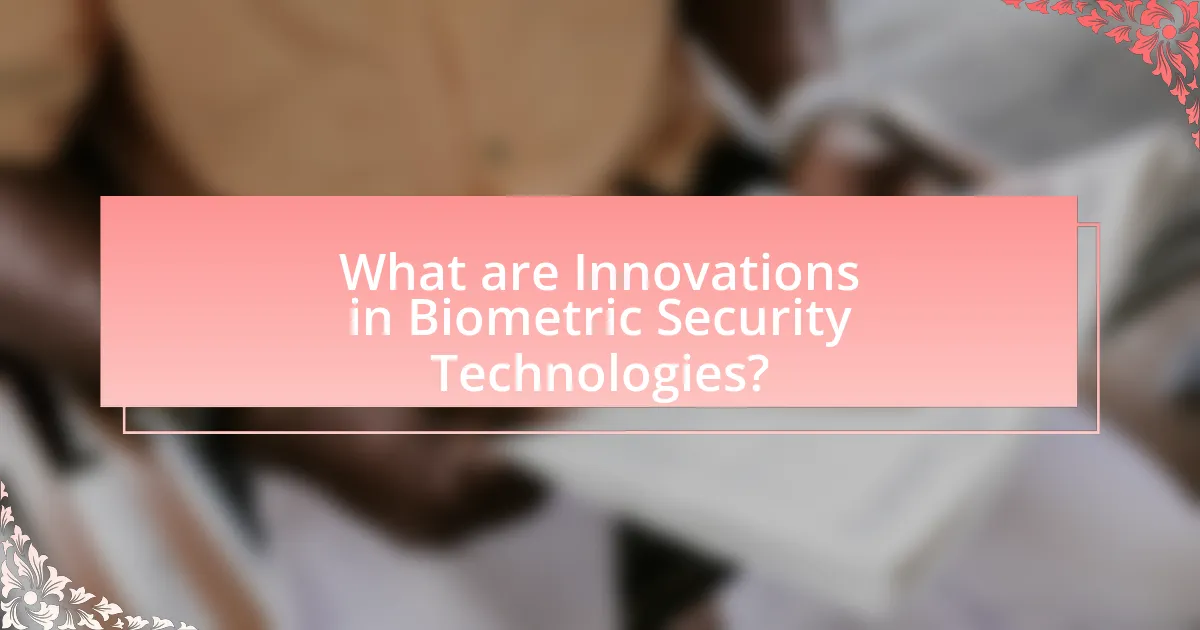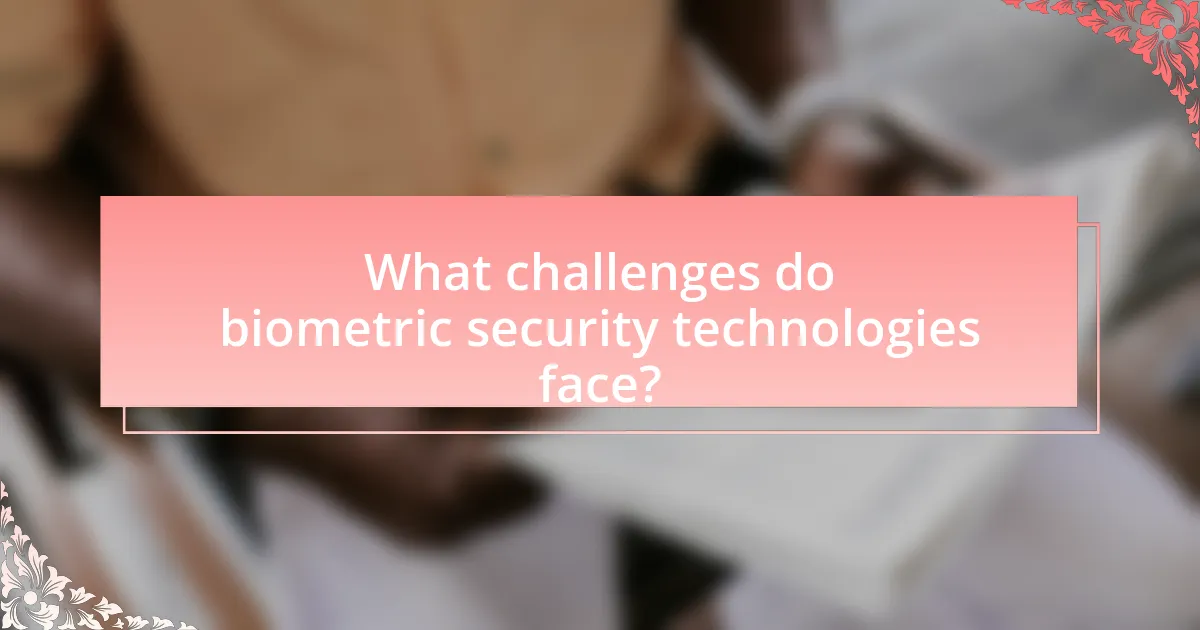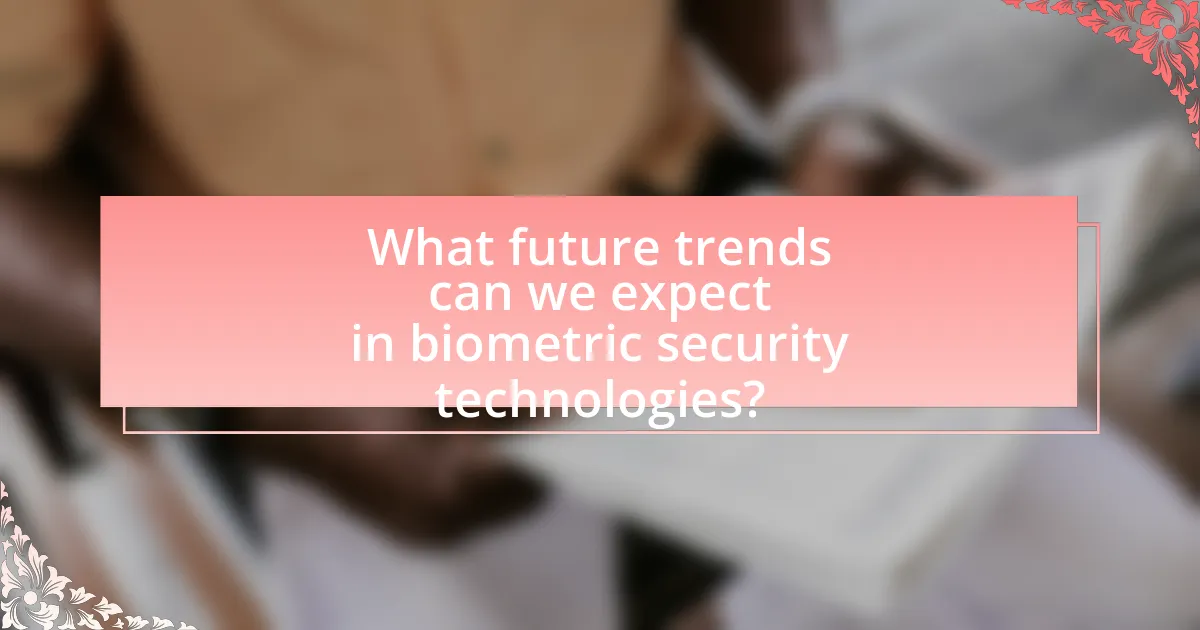Innovations in biometric security technologies encompass advancements such as multi-modal biometrics, which integrate various biometric traits to enhance accuracy and security. The evolution of these technologies has transitioned from simple fingerprint recognition to sophisticated systems utilizing artificial intelligence and machine learning for real-time analysis. Key historical milestones, including the introduction of fingerprint analysis and facial recognition, have shaped the current landscape, while recent developments focus on improving accuracy and user convenience. Despite the benefits of enhanced security and reduced fraud, challenges such as privacy concerns and data security remain critical issues that organizations must address when implementing biometric solutions.

What are Innovations in Biometric Security Technologies?
Innovations in biometric security technologies include advancements such as multi-modal biometrics, which combine various biometric traits like fingerprints, facial recognition, and iris scans to enhance accuracy and security. These innovations are driven by the need for more robust security measures in response to increasing cyber threats. For instance, the integration of artificial intelligence in biometric systems allows for real-time analysis and improved recognition rates, with studies showing that AI-enhanced systems can reduce false acceptance rates by up to 50%. Additionally, the development of biometric wearables, such as smartwatches with integrated fingerprint sensors, exemplifies the trend towards convenience and accessibility in biometric authentication.
How have biometric security technologies evolved over time?
Biometric security technologies have evolved significantly from simple fingerprint recognition to advanced multi-modal systems. Initially, biometric systems focused on single traits, such as fingerprints, which became widely used in the 1960s and 1970s for identification purposes. The 1990s saw the introduction of facial recognition and iris scanning, enhancing security measures by utilizing unique biological characteristics.
In the 2000s, the integration of biometric technologies with digital systems led to the development of more sophisticated algorithms and machine learning techniques, improving accuracy and speed. By the 2010s, biometric authentication became commonplace in consumer devices, such as smartphones, with features like fingerprint sensors and facial recognition technology.
Recent advancements include the use of artificial intelligence to analyze biometric data in real-time, increasing the reliability of these systems. According to a report by MarketsandMarkets, the global biometric market is projected to grow from $30 billion in 2020 to over $60 billion by 2025, reflecting the increasing adoption and innovation in biometric security technologies.
What historical milestones have shaped biometric security innovations?
The historical milestones that have shaped biometric security innovations include the introduction of fingerprint analysis in the late 19th century, the development of facial recognition technology in the 1960s, and the implementation of iris recognition systems in the 1990s. Fingerprint analysis was pioneered by Sir Francis Galton and later popularized by Edward Henry, establishing a foundation for biometric identification. The 1960s saw the first facial recognition systems developed by Woodrow W. Bledsoe, which utilized geometric measurements of facial features. Iris recognition technology was introduced by John Daugman, who created algorithms that could accurately identify individuals based on unique patterns in the iris. These milestones have significantly influenced the evolution and adoption of biometric security systems across various sectors.
What technological advancements have driven recent innovations?
Recent innovations in biometric security technologies have been driven primarily by advancements in artificial intelligence (AI) and machine learning algorithms. These technologies enhance the accuracy and speed of biometric recognition systems, enabling real-time processing of biometric data such as fingerprints, facial recognition, and iris scans. For instance, deep learning techniques have significantly improved the ability to recognize faces in diverse lighting conditions and angles, as evidenced by a study from the National Institute of Standards and Technology, which found that modern facial recognition systems can achieve accuracy rates exceeding 99%. Additionally, the integration of cloud computing has facilitated the storage and analysis of vast amounts of biometric data, allowing for more sophisticated security applications across various sectors, including finance and law enforcement.
What types of biometric security technologies are currently available?
Currently available biometric security technologies include fingerprint recognition, facial recognition, iris recognition, voice recognition, and palm vein recognition. Fingerprint recognition analyzes unique patterns on an individual’s fingertips, while facial recognition uses algorithms to identify facial features. Iris recognition scans the unique patterns in the colored part of the eye, and voice recognition analyzes vocal characteristics for identification. Palm vein recognition utilizes the unique patterns of veins in the palm for authentication. These technologies are widely used in various applications, including mobile devices, security systems, and access control, demonstrating their effectiveness and reliability in enhancing security measures.
What are the most common biometric modalities used today?
The most common biometric modalities used today are fingerprint recognition, facial recognition, iris recognition, and voice recognition. Fingerprint recognition is widely utilized due to its uniqueness and ease of capture, with studies indicating that it accounts for over 60% of biometric systems in use. Facial recognition technology has gained popularity, especially in security and mobile devices, with a market growth rate projected at 16% annually. Iris recognition is known for its high accuracy and is often used in high-security environments, while voice recognition is increasingly integrated into personal assistants and security systems, with a significant rise in adoption in recent years.
How do different biometric technologies compare in terms of accuracy and reliability?
Different biometric technologies exhibit varying levels of accuracy and reliability, with fingerprint recognition generally being the most accurate, followed by facial recognition and iris scanning. Fingerprint recognition boasts an accuracy rate exceeding 99% in optimal conditions, while facial recognition accuracy can range from 85% to 95%, depending on environmental factors and algorithm sophistication. Iris scanning offers high reliability, often achieving accuracy rates similar to fingerprints, but can be affected by lighting and user positioning. Studies, such as those conducted by the National Institute of Standards and Technology (NIST), highlight these differences, showing that while all biometric systems have strengths, their performance can significantly vary based on implementation and context.
What are the key benefits of adopting biometric security technologies?
The key benefits of adopting biometric security technologies include enhanced security, improved user convenience, and reduced fraud. Enhanced security is achieved through unique biological traits, such as fingerprints or facial recognition, which are difficult to replicate, thereby significantly lowering the risk of unauthorized access. Improved user convenience arises from the elimination of the need for passwords or physical tokens, allowing for quicker and more seamless authentication processes. Additionally, biometric systems can reduce fraud; for instance, a study by the National Institute of Standards and Technology found that biometric authentication can decrease identity theft incidents by up to 99%. These benefits collectively make biometric security technologies a compelling choice for organizations seeking to bolster their security measures.
How do biometric systems enhance security compared to traditional methods?
Biometric systems enhance security compared to traditional methods by utilizing unique physiological or behavioral characteristics for identification and authentication. Unlike traditional methods, such as passwords or PINs, which can be forgotten, stolen, or easily guessed, biometric traits like fingerprints, facial recognition, or iris patterns are inherently tied to the individual and are difficult to replicate. For instance, a study by the National Institute of Standards and Technology (NIST) found that biometric systems can reduce the risk of unauthorized access by up to 99% when compared to traditional password systems. This significant improvement in security is due to the difficulty in forging biometric data, making it a more reliable and secure method for protecting sensitive information and access points.
What cost savings can organizations expect from implementing biometric solutions?
Organizations can expect significant cost savings from implementing biometric solutions, primarily through reduced administrative expenses and enhanced security. By automating identity verification processes, biometric systems minimize the need for manual checks and paperwork, leading to lower labor costs. For instance, a study by the International Biometric + Identity Association found that companies can save up to 30% on operational costs by replacing traditional security measures with biometric technology. Additionally, biometric solutions reduce fraud and identity theft, which can lead to substantial financial losses; organizations that adopt these systems often report a decrease in security breaches, further contributing to overall cost savings.

What challenges do biometric security technologies face?
Biometric security technologies face several significant challenges, including privacy concerns, data security, and accuracy issues. Privacy concerns arise because biometric data, such as fingerprints or facial recognition, is sensitive and can be misused if not properly protected. Data security is critical, as breaches can lead to unauthorized access to personal information; for instance, the 2015 data breach of the U.S. Office of Personnel Management exposed the biometric data of over 5 million individuals. Accuracy issues also present challenges, as biometric systems can struggle with false positives or negatives, particularly in diverse populations or under varying environmental conditions. These challenges highlight the need for robust security measures and ethical considerations in the deployment of biometric technologies.
What privacy concerns are associated with biometric data collection?
Biometric data collection raises significant privacy concerns primarily due to the potential for misuse and unauthorized access to sensitive personal information. The unique nature of biometric identifiers, such as fingerprints and facial recognition, means that once compromised, they cannot be changed like passwords. Studies indicate that 64% of individuals express concern over how their biometric data is stored and used, highlighting fears of surveillance and data breaches. Furthermore, the lack of comprehensive regulations governing biometric data exacerbates these concerns, as many organizations may not implement adequate security measures, increasing the risk of exploitation.
How do regulations impact the use of biometric technologies?
Regulations significantly impact the use of biometric technologies by establishing legal frameworks that govern data collection, storage, and usage. These regulations, such as the General Data Protection Regulation (GDPR) in Europe, mandate strict consent requirements and data protection measures, which can limit the deployment of biometric systems. For instance, GDPR requires organizations to demonstrate a legitimate purpose for processing biometric data, thereby influencing how companies design and implement these technologies. Additionally, regulations can impose penalties for non-compliance, which further incentivizes organizations to adhere to legal standards, ultimately shaping the development and adoption of biometric solutions in various sectors.
What measures can be taken to protect biometric data from breaches?
To protect biometric data from breaches, organizations should implement strong encryption methods for data storage and transmission. Encryption ensures that even if data is intercepted or accessed without authorization, it remains unreadable without the appropriate decryption key. According to a 2020 report by the Ponemon Institute, 63% of organizations that experienced a data breach did not encrypt sensitive data, highlighting the importance of this measure. Additionally, employing multi-factor authentication can further secure access to biometric systems, making it more difficult for unauthorized users to gain entry. Regular security audits and updates to biometric systems also play a crucial role in identifying vulnerabilities and ensuring compliance with the latest security standards.
How do technological limitations affect biometric security systems?
Technological limitations significantly hinder the effectiveness of biometric security systems by impacting their accuracy, reliability, and user acceptance. For instance, factors such as sensor quality, environmental conditions, and algorithmic efficiency can lead to false positives or negatives, undermining security. Research indicates that biometric systems can have error rates as high as 1 in 1,000 for fingerprint recognition under suboptimal conditions, which can compromise security integrity. Additionally, limitations in data processing capabilities can slow down authentication processes, leading to user frustration and reduced adoption rates. These technological constraints highlight the need for continuous advancements in sensor technology and algorithm development to enhance the performance of biometric security systems.
What are the common technical issues encountered in biometric systems?
Common technical issues encountered in biometric systems include false acceptance and rejection rates, sensor quality, environmental factors, and data security concerns. False acceptance occurs when unauthorized individuals are incorrectly granted access, while false rejection happens when authorized users are denied access. These issues are often influenced by the quality of sensors used, as low-quality sensors can lead to inaccurate readings. Environmental factors, such as lighting and temperature, can also affect the performance of biometric systems. Additionally, data security concerns arise from the potential for biometric data to be hacked or misused, highlighting the need for robust encryption and secure storage solutions.
How can organizations mitigate the risks associated with biometric technology failures?
Organizations can mitigate the risks associated with biometric technology failures by implementing multi-factor authentication systems. This approach combines biometric data with additional verification methods, such as passwords or security tokens, thereby reducing reliance on a single biometric factor. Research indicates that multi-factor authentication can significantly enhance security; for instance, a study by the National Institute of Standards and Technology (NIST) found that using multiple authentication factors can decrease the likelihood of unauthorized access by up to 99.9%. Additionally, organizations should regularly update and maintain biometric systems to address vulnerabilities and ensure accuracy, as outdated systems are more prone to failures. Regular audits and risk assessments can also help identify potential weaknesses in biometric implementations, allowing organizations to proactively address issues before they lead to failures.

What future trends can we expect in biometric security technologies?
Future trends in biometric security technologies include the integration of artificial intelligence for enhanced accuracy, the adoption of multimodal biometrics, and the increased use of biometric authentication in mobile devices. AI algorithms improve the precision of biometric systems by reducing false acceptance and rejection rates, as evidenced by studies showing a 30% improvement in accuracy when AI is applied. Multimodal biometrics, which combines different biometric traits such as fingerprints and facial recognition, is gaining traction due to its ability to provide more secure and reliable authentication. Additionally, the proliferation of biometric sensors in smartphones and wearables indicates a shift towards more user-friendly and accessible security solutions, with a report from MarketsandMarkets projecting the biometric market to reach $59.31 billion by 2025, driven by these innovations.
How is artificial intelligence influencing biometric security innovations?
Artificial intelligence is significantly enhancing biometric security innovations by improving accuracy, speed, and adaptability in recognition systems. AI algorithms, particularly deep learning techniques, enable biometric systems to analyze vast datasets, leading to more precise identification and verification processes. For instance, AI-driven facial recognition systems can achieve accuracy rates exceeding 99% in controlled environments, as demonstrated by studies from the National Institute of Standards and Technology (NIST). Additionally, AI enhances the ability to detect spoofing attempts, such as using photographs or masks, by analyzing subtle behavioral patterns and physiological traits. This integration of AI into biometric security not only strengthens security measures but also facilitates user-friendly experiences, making biometric authentication more reliable and efficient across various applications.
What role does machine learning play in enhancing biometric accuracy?
Machine learning significantly enhances biometric accuracy by improving the algorithms used for recognition and classification tasks. These algorithms analyze vast datasets of biometric samples, such as fingerprints, facial images, and iris patterns, to identify patterns and features that are crucial for accurate identification. For instance, a study published in the IEEE Transactions on Information Forensics and Security demonstrated that deep learning techniques can increase facial recognition accuracy by over 25% compared to traditional methods. This improvement is attributed to machine learning’s ability to adapt and learn from new data, thereby reducing false acceptance and false rejection rates in biometric systems.
How might future biometric technologies evolve to address current limitations?
Future biometric technologies may evolve by integrating multi-modal systems that combine various biometric traits, such as facial recognition, fingerprint scanning, and iris recognition, to enhance accuracy and security. Current limitations include issues with spoofing and environmental factors affecting performance; multi-modal systems can mitigate these by requiring multiple forms of verification, making it harder for unauthorized access. For instance, research indicates that combining facial recognition with voice recognition can reduce false acceptance rates by up to 50%, demonstrating the effectiveness of this approach. Additionally, advancements in artificial intelligence and machine learning will enable biometric systems to adapt to new threats and improve their recognition algorithms, further addressing existing vulnerabilities.
What industries are likely to benefit most from future biometric innovations?
The healthcare, financial services, and security industries are likely to benefit most from future biometric innovations. In healthcare, biometric technologies can enhance patient identification and streamline access to medical records, improving patient safety and care efficiency. The financial services sector can leverage biometrics for secure transactions and fraud prevention, as evidenced by the increasing adoption of fingerprint and facial recognition for mobile banking. Additionally, the security industry can utilize biometric systems for access control and surveillance, which can significantly reduce unauthorized access incidents. These industries are already investing in biometric solutions, indicating a strong trend towards integration and reliance on these technologies for enhanced security and operational efficiency.
How can healthcare leverage biometric security for patient safety?
Healthcare can leverage biometric security for patient safety by implementing systems that use unique biological traits, such as fingerprints or facial recognition, to authenticate patient identities and access medical records. This technology enhances security by ensuring that only authorized personnel can access sensitive patient information, thereby reducing the risk of data breaches and identity theft. For instance, a study published in the Journal of Medical Systems found that biometric authentication significantly decreased unauthorized access incidents in healthcare settings, demonstrating its effectiveness in safeguarding patient data.
What potential applications exist for biometric technologies in finance and banking?
Biometric technologies have several potential applications in finance and banking, primarily focused on enhancing security and improving customer experience. These applications include biometric authentication methods such as fingerprint recognition, facial recognition, and iris scanning for secure access to accounts and transactions. For instance, banks can implement fingerprint scanners on mobile banking apps to ensure that only authorized users can access sensitive financial information. Additionally, biometric technologies can facilitate seamless payment processes, allowing customers to make transactions using their biometric data instead of traditional passwords or PINs. According to a report by MarketsandMarkets, the global biometric market in banking is expected to grow significantly, driven by the increasing need for secure and efficient customer verification methods.
What best practices should organizations follow when implementing biometric security technologies?
Organizations should follow several best practices when implementing biometric security technologies to ensure effectiveness and security. First, they must conduct a thorough risk assessment to identify potential vulnerabilities associated with biometric data. This assessment helps organizations understand the specific threats they face and tailor their biometric solutions accordingly.
Second, organizations should prioritize data protection by employing strong encryption methods for storing and transmitting biometric data. According to the National Institute of Standards and Technology (NIST), encryption significantly reduces the risk of data breaches, which is critical given that biometric data is sensitive and unique to individuals.
Third, organizations need to ensure compliance with relevant regulations, such as the General Data Protection Regulation (GDPR) in Europe, which mandates strict guidelines for handling personal data, including biometric information. Compliance not only protects individuals’ privacy but also mitigates legal risks for organizations.
Fourth, organizations should implement multi-factor authentication (MFA) alongside biometric systems. Research by the Ponemon Institute indicates that MFA can enhance security by adding an additional layer of verification, making unauthorized access more difficult.
Finally, continuous monitoring and regular updates of biometric systems are essential to address emerging threats and vulnerabilities. The Cybersecurity and Infrastructure Security Agency (CISA) emphasizes that ongoing assessments and updates are crucial for maintaining the integrity of security systems.
By following these best practices, organizations can effectively implement biometric security technologies while safeguarding sensitive data and ensuring compliance with legal standards.


